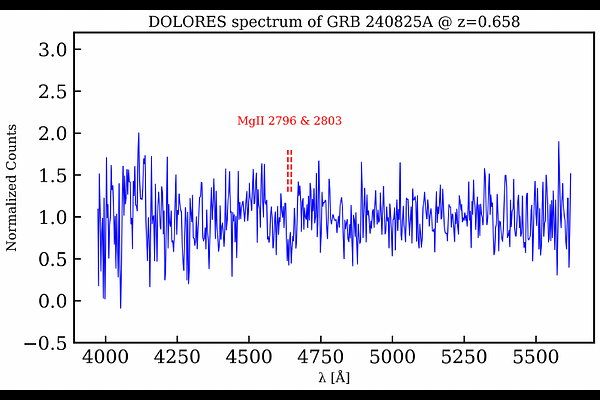GRB 240825A: Early Reverse Shock and Its Physical Implications

GRB 240825A: Early Reverse Shock and Its Physical Implications
Chao Wu, Yun Wang, Hua-Li Li, Li-Ping Xin, Dong Xu, Benjamin Schneider, Antonio de Ugarte Postigo, Gavin Lamb, Andrea Reguitti, Andrea Saccardi, Xing Gao, Xing-Ling Li, Qiu-Li Wang, Bing Zhang, Jian-Yan Wei, Shuang-Nan Zhang, Frédéric Daigne, Jean-Luc Atteia, Maria-Grazia Bernardini, Hong-bo Cai, Arnaud Claret, Bertrand Cordier, Jin-Song Deng, Olivier Godet, Diego Götz, Xu-Hui Han, Zhe Kang, Guang-Wei Li, Zhen-Wei Li, Cheng-Zhi Liu, Xiao-Meng Lu, You Lv, Julian P Osborne, Jesse Palmerio, Yu-Lei Qiu, Stéphane Schanne, Damien Turpin, Susanna Diana Vergani, Jing Wang, Yu-Jie Xiao, Wen-Jin Xie, Yang Xu, Zhu-Heng Yao, Pin-Pin Zhang, Ruo-Son Zhang, Cheng-Wei Zhu, Riccardo Brivio, Stefano Covino, Paolo D'Avanzo, Matteo Ferro, Andrea Melandri, Andrea Rossi, José Feliciano Agüí Fernández, Christina C. Thöne, Chun-Hai Bai, Ali Esamdin, Abdusamatjan Iskandar, Shahidin Yaqup, Yu Zhang, Tu-Hong Zhong, Shao-Yu Fu, Shuai-Qing Jiang, Xing Liu, Jie An, Zi-Pei Zhu, Jia-Xin Cao, En-Wei Liang, Da-Bin Lin, Xiang-Gao Wang, Guo-Wang Du, Xin-Zhong Er, Yuan Fang, Xiao-Wei Liu, Christophe Adami, Michel Dennefeld, Emeric Le Floc'h, Johan Peter Uldall Fynbo, Páll Jakobsson, Daniele Bjørn Malesani, Zhi-Ping Jin, Jia Ren, Hao Wang, Da-Ming Wei, Hao Zhou, Sergio Campana, Shiho Kobayashi, Massimiliano De Pasquale
AbstractEarly multi-wavelength observations offer crucial insights into the nature of the relativistic jets responsible for gamma-ray bursts and their interaction with the surrounding medium.We present data of GRB 240825A from 17 space- and ground-based telescopes/instruments, covering wavelengths from NIR/optical to X-ray and GeV, and spanning from the prompt emission to the afterglow phase triggered by Swift and Fermi. The early afterglow observations were carried out by SVOM/C-GFT, and spectroscopic observations of the afterglow by GTC, VLT, and TNG determined the redshift of the burst ($z = 0.659$) later.A comprehensive analysis of the prompt emission spectrum observed by Swift-BAT and Fermi-GBM/LAT reveals a rare and significant high-energy cutoff at ~76 MeV. Assuming this cutoff is due to $\gamma\gamma$ absorption allows us to place an upper limit on the initial Lorentz factor, $\Gamma_0 < 245$. The optical/NIR and GeV afterglow light curves be described by the standard external shock model, with early-time emission dominated by a reverse shock (RS) and a subsequent transition to forward shock (FS) emission. Our afterglow modelling yields a consistent estimate of the initial Lorentz factor ($\Gamma_{\rm 0} \sim 234$). Furthermore, the RS-to-FS magnetic field ratio ($\mathcal{R}_B \sim 302$) indicates that the reverse shock region is significantly more magnetized than the FS region. An isotropic-equivalent kinetic energy of $E_{\text{k,iso}} = 5.25 \times 10^{54}$ erg is derived, and the corresponding $\gamma$-ray radiation efficiency is estimated to be $\eta_{\gamma}$ = 3.1%. On the other hand, the standard afterglow model can not reproduce the X-ray light curve of GRB 240825A, calling for improved models to characterize all multi-wavelength data.